
Pinhole photography.
Pinhole photographs can be taken on a camera made specifically for that purpose, using film or photographic paper, or by modifying a plate camera, film camera or digital camera by replacing the lens with a pinhole.
Pinhole photographs have lower definition than a normal photograph but have a huge depth-of-field, and due to the tiny amount of light that gets through the pinhole, the exposure times can be long, if so the camera usually needs to be on a tripod or a firm surface.
On this page:
Pinhole photography using a Digital camera
Pinhole photography using a 4x5 format camera
 Digital pinhole camera |
 4x5 format pinhole camera |
Pinhole photography using a digital camera.
To make a test pinhole I wrapped some aluminium baking foil tightly over a Fujifilm 16mm extension tube and secured it with an elastic band. I then made a tiny hole in the centre of the foil with the pin. I fitted the pinholed extension tube to an old Fujifilm XE1 that I bought for next-to-nothing, put the camera on a tripod and set the shutter speed to Auto. The image produce was awful.

I already knew that photos taken by a pinhole camera have a soft resolution but my image was very foggy. This I realised was due to flare caused by the reflection of light between the sensor and the aluminium foil because when the sun came out it was even worse. I also knew that the pinhole had to be perfectly circular for the best resolution, and that this could not be achieved with baking foil because the pin would have produced a little volcano shaped hole. But I was pleased that I had managed to create the sort of photo that would have been marvelled at around two hundred years ago.
I needed something more substantial than foil to create a pinhole in so I looked around my workshop and found a strip of 0.25mm-thick phosphor bronze.

I laid the strip on a piece of hard wood, took the smallest sewing needle that I could find, and tapped it with a small hammer until the point just broke through the metal. I measured the diameter of the needle as far as the point where it had entered the hole using a vernier caliper. It was about 0.2mm. Because the point of the needle had raised a tiny volcano shape where it had exited the strip, I removed it using very fine emery paper.
I checked the pinhole with a magnifying lens. It seemed to be quite round and even. This is important as a ragged hole will produce diffraction effects. I trimmed the strip around the pinhole to make a disc about 15mm in diameter.

I drilled a 3mm hole in the centre of a spare Fujifilm body cap and glued the disc to the inside. I estimated the distance from the inside of the cap to the camera sensor to be about 23mm. This will give an equivalent focal length of 35mm on an APS-C camera, which is just what I wanted.
I tested it. There was still some flare, so I cut a disc of black felt with a 3mm hole in the centre and glued it around the pinhole to prevent possible reflections between the shiny metal disc and the sensor.

The result was an image that was much clearer than before and there was no flare. It had the typical pinhole photo soft resolution just as I expected to see.
Photo: Fuji X-E1, approx 0.2mm pinhole, exposure 2.1 seconds ISO 800. Tripod.
I decided to try improving the quality even more. My pinhole was made 0.25mm-thick phosphor bronze shim I found out was much thicker than should be used. So I thinned down the centre of the disc quite a bit using fine emery paper. I was unable to measure accurately the thickness achieved at the very centre but it was probably around 0.1mm.
It did nothing to improve the resolution so I decided to buy an accurately manufactured pinhole.
At this point I did some investigation about pinhole sizes. For more details about the relationship between the pinhole size and the focal length go to my slightly more technical page here.

My new pinhole was a double-etched 0.2mm hole in 0.05mm-thick stainless steel disc bought from Pinhole Solutions.
I fixed it inside the body cap with a few tiny spots of glue at the edges and covered it with a black felt disc with the 3mm hole in the centre to prevent reflections.

This new pinhole improved the resolution markedly.
When I compared the field of view achieved with the pinhole-cap to that of my Fuji 23mm f2 lens and found that they were very similar.
Photo: Fuji X-E1, 0.2mm pinhole, exposure 1.4 seconds at ISO 200. Tripod.
I used a tripod due to the low shutter speeds necessary for the pinhole, but I found that hand holding was possible on a bright day at ISO 3200 and above. The higher ISO values didn't seem to affect the resolution much until ISO 12800.

I also tried the pinhole cap attached to a 16mm extension tube to increase the pinhole to sensor distance to about 39mm, giving an equivalent focal length of about 58mm on an APS-C camera. This did increase the exposure times but made it a better focal length for portraits. The subject was pleased by the soft resolution and the lack of wrinkles!
It could never be a true portrait lens though, because it does not have a shallow depth of field to throw the background out of focus because the depth of field of a pinhole is so huge, but it works fine with a plain background. To be strictly correct it cannot even be called a lens because it doesn't contain a lens.
Photo: Fuji X-E3, 0.2mm pinhole in 23mm focal-length body-cap, plus 16mm extension tube. 2 seconds, ISO 12800, Fujifilm Acros film simulation, one 60cm LED-tube ceiling light. Cropped square but not processed.

Photo: West Bay, Dorset. Fuji X-E3, 0.2mm pinhole body-cap, focal-length 23mm. 1/5 second, ISO 200, Fujifilm Velvia film simulation.
This photo was taken on 30 April 2023 and submitted for World Pinhole Photography Day which was on that day.
On World Pinhole Photography Day, pinhole photographers from all over the world take photographs and submit them to the World Pinhole Photography Day website.
The link below opens at page one of the four pages of UK photographs submitted for that day. Pinhole photos from around the world can also be seen.

Fujifilm X-E3 pinhole camera
Digital pinhole photos
All photos are straight from the camera with no post processing, except for perhaps, some cropping and some spotting (removal of spots). Dust on a camera's sensor can show up as a tiny feint mark on an image but when using a pinhole, dust shows up as very conspicuous spots. All photos were taken with a 0.2mm pinhole in a Fujifilm body-cap, focal-length 23mm. I also increase the contrast and sharpness settings on my Fuji cameras and often use a more vivid film simulation such as Fujifilm Velvia.
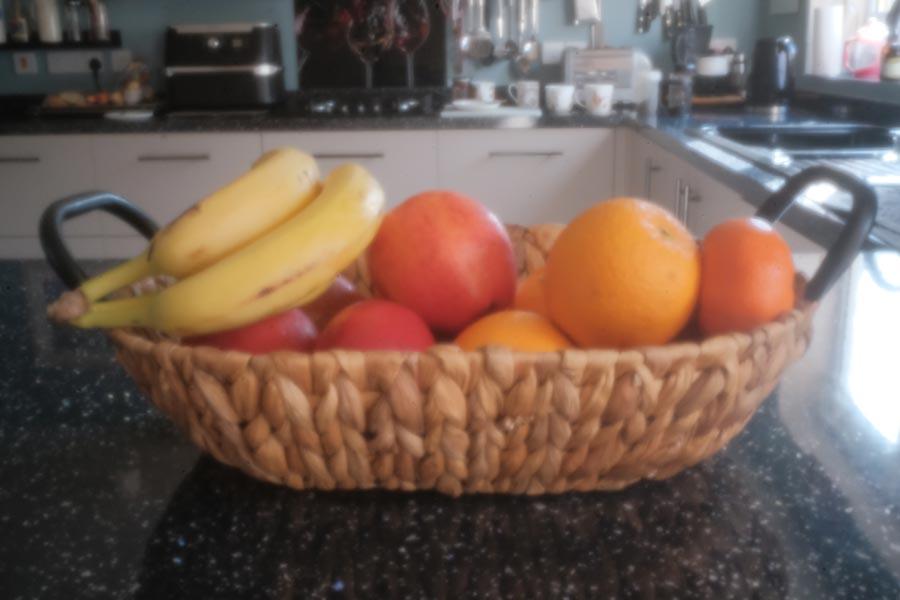
Test shot in the kitchen. 2 sec. ISO 3200.
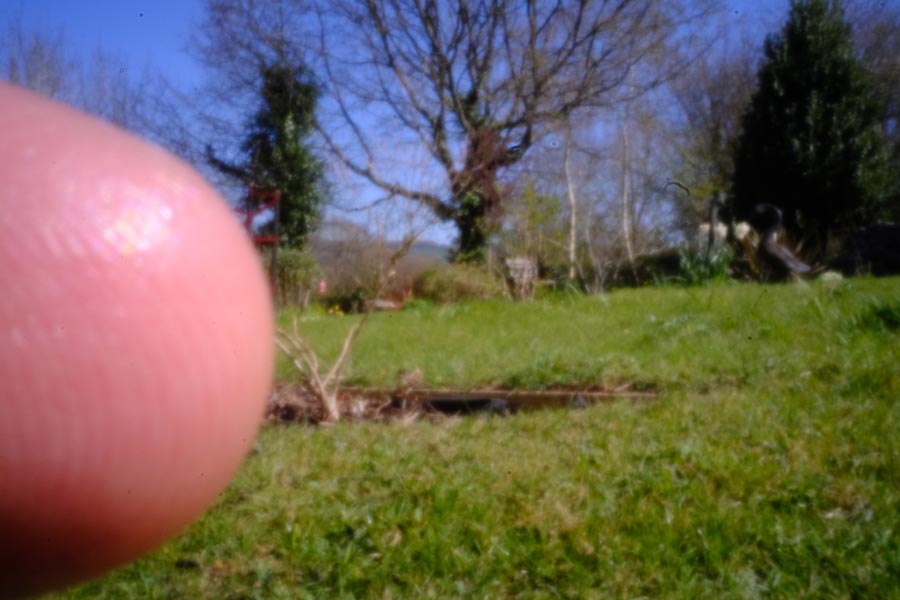
Fingertip. Soft resolution but huge depth of field.

The Paris Hotel, Coverack, Cornwall.
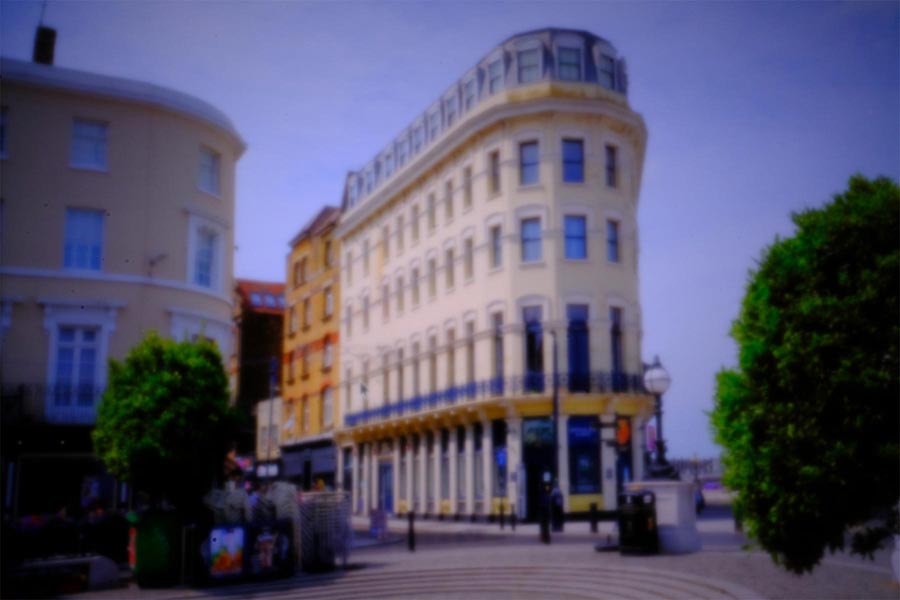
Interesting Building, Margate, Kent.

A 'Vintage photo' straight from the camera.
Pinhole photography using a 4x5 format camera with direct-positive black-and-white photographic paper.
After looking at the images submitted to the World Pinhole Photography Day website I couldn't help but notice the better resolution of the photographs that were taken with larger format pinhole cameras. I wondered if it had something to do with the the increase in size of the surface receiving the images projected by the pinhole. My Fujifilm body-cap pinhole projects an image onto a digital sensor measuring about 24mm x 16mm, but the area of light sensitive film or paper receiving the image in a 4x5 pinhole camera is about 115mm x 90mm.
This type of camera can be completely home-made or made from a variety of objects such as a tin, a cardboard box or a wooden box. A darkroom or somewhere really dark is normally required to load the photographic paper and to develop the photo afterwards.
I thought about building one but I decided to buy one instead. I chose a Pinsta 4x5 format camera, which uses direct positive paper to produce the finished image. This method has the added advantage missing out the film stage completely and also because of the design of the camera a darkroom is not needed to develop the image. The camera can be loaded in a changing bag or anywhere dark and the image can be developed anywhere too.

The camera is made of ABS and has been designed so that the back of the camera, where the photographic paper is held, becomes the developing tray after the exposure has been made. Pre-mixed developing and fixing chemicals can be injected into the camera, timed, and removed again through a tiny light-tight hole using syringes. This only takes a few minutes. Once the fixer has been applied, the camera can be opened to reveal the image and the print can then be washed.
This means that images can be developed on location, even in broad daylight. Similarly the camera can be reloaded anywhere using a changing bag, or anywhere dark. A changing bag is a light-tight bag with light-tight arm holes designed to allow reloading to be done by feel.
If using a darkroom, the camera can be opened and the chemicals applied directly into the tray, the advantage here being that the image can be seen developing (under a red darkroom light) and stopped when the it has reached the required density.

The recommended paper for this camera is Ilford Harman Direct Positive Paper, which produces contrasty images, so less contrasty subjects work better, unless you actually want a high contrast print. The exposure times vary from minutes on a sunny day to an hour or more on a very dull day, and several hours if indoors. It takes practice to get a good result, but the rewards are worth the effort. A print can be produced within ten minutes of making the exposure, although it will need a little time to dry.
It is possible to reduce the contrast of an image and at the same time reducing the exposure time required by 'flashing' the paper with a burst of light in advance. There is a white diffuser on the selector on the front of the the camera that allows a light source such as a torch to be used to perform the flashing in advance of taking a photo. I will report on this when I have perfected it.
It's great to be able to take photos, develop them on the spot and then reload the camera in a changing bag to take more photos. But if I am not too far from home I prefer to transfer the exposed sheets into a light tight box and reload the camera for more shots. Then later I can develop the shots in my garage/darkroom under a red light so that I can see and so more easily control the developing of the prints.
Note that with direct positive paper the developed image will be reversed left to right. So, the image may need to be copied with a digital camera or a scanner then reversed before being re-printed. This may seem a odd thing to do but the resulting image is still a photograph that was taken with a pinhole camera, just as a print produced from a negative by an enlarger is still a photograph that was taken with a film camera.
4x5 format. First pinhole photos.
The developed prints were photographed with a Fujifilm APS-C camera. No post processing except for cropping and reversing.
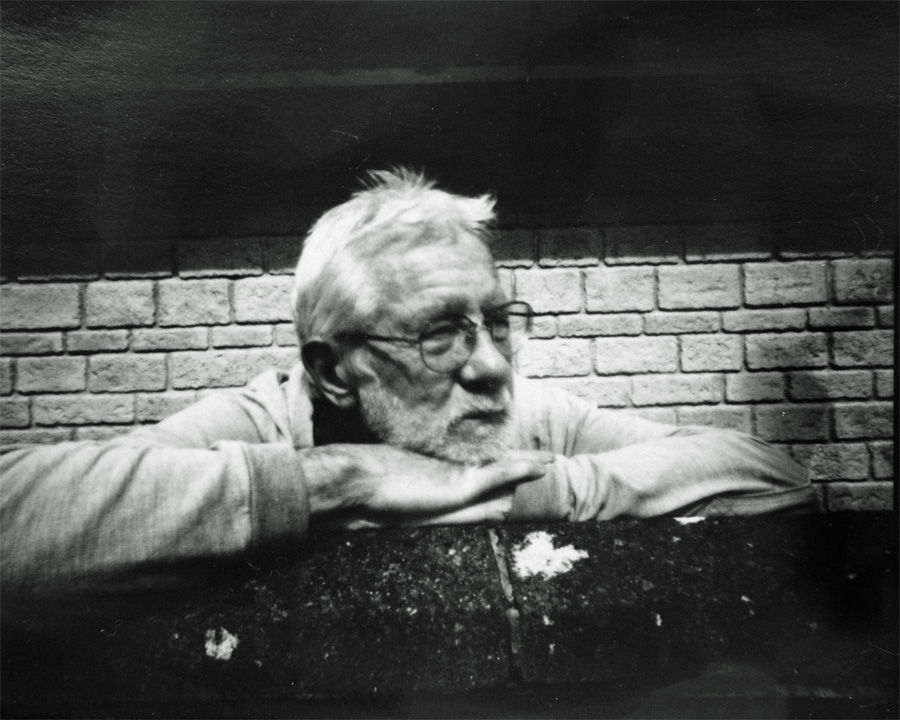
Just keep still for one minute.
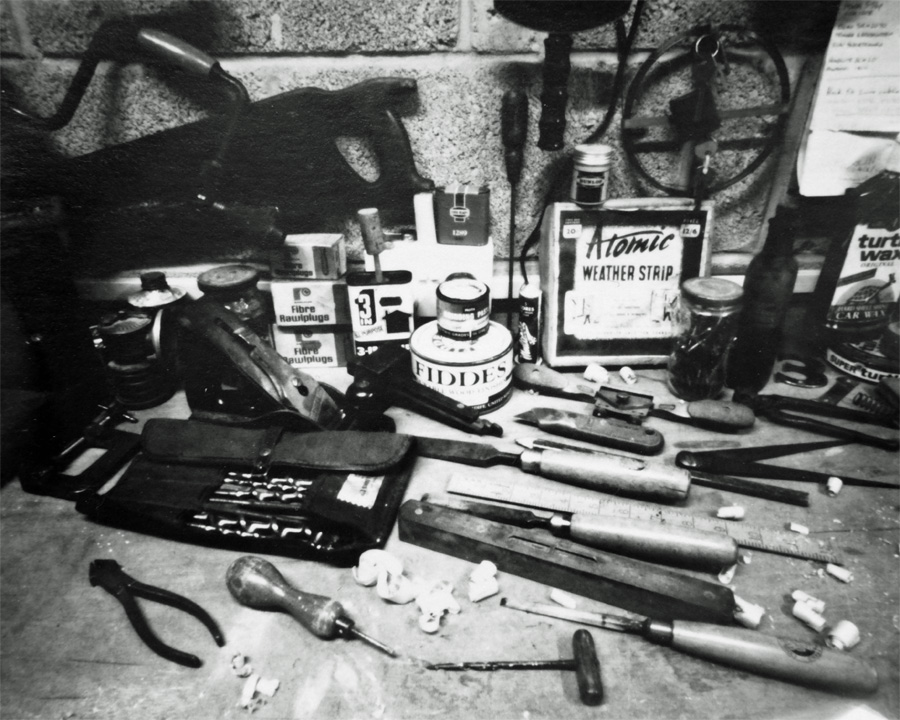
Workbench. Taken under an LED ceiling light. 5 hours exposure.
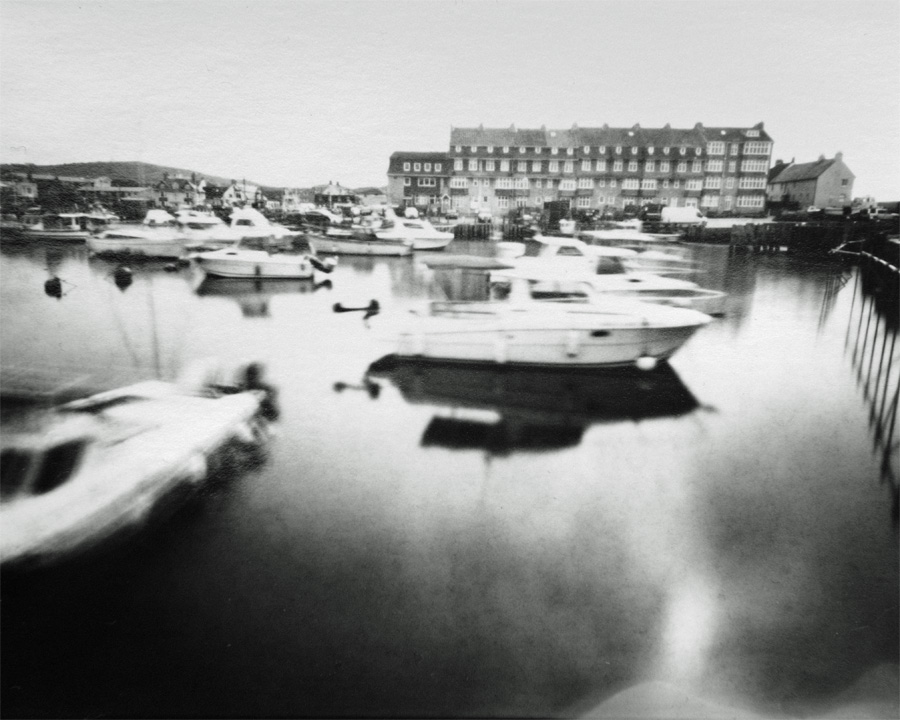
West Bay Harbour, Dorset. The 2.5 minute exposure has blurred the constantly bobbing boats, but has caused the surface of the choppy water to appear smooth.
This photo was submitted for World Pinhole Photography Day 2024.
World Pinhole Photography Day 2024 was on April 28th 2024. Click here to go to page one of the four pages of photos submitted from the UK. Photos from around the world can also be seen.
Contact me here if you have a question or any advice.